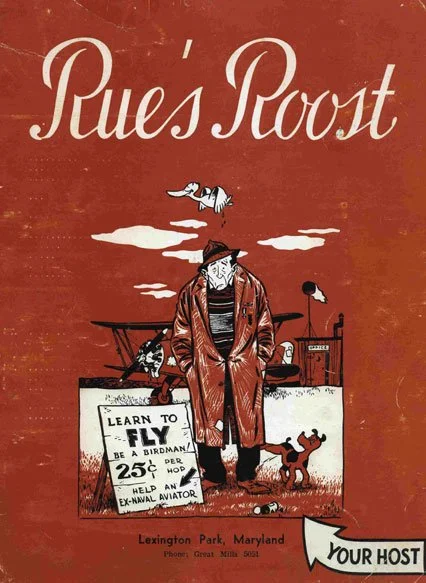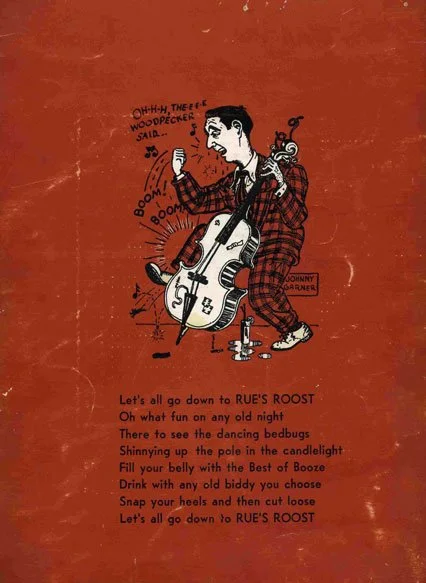Knights of the Round Table
Alexandra Lynn Todak and Julia A. King
Originally appearing in Slackwater, Volume 6
The Roost Menu, front cover. St. Mary's College of Maryland Archives.
Consumerism has been a fact of American life since the 18thcentury, when English merchants figured out that the colonists would pay high prices for clothing, furnishings, and even tea – goods that made the colonists feel like Englishmen and not like provincials in some far-flung empire. Industrialization in the 19th century provided even more goods for consumers, but it was only in the mid-20thcentury, after the end of World War II, that consumer goods became widely and easily available to all Americans. In particular, automobiles, television sets, and even houses were suddenly affordable, available, and within relatively easy reach of most people.
For the men and women flooding St. Mary’s County for jobs related to the Patuxent River Naval Air Station, the place must have seemed like a colony in some far-flung empire. Harold Herndon, who came to St. Mary’s in 1960 to interview for a teaching position with the Board of Education, remembers that he “couldn’t find the place on a map. It took forever to get down here and I was trying to figure out, what in the world have I gotten myself into?” All these new souls would need those goods and services increasingly expected in post-World War II America, goods and services that signified one’s status as an American.
As Lord Baltimore had discovered in the 17th century, so these new arrivals were discovering in the mid-20th, there was opportunity – and lots of it – right here in St. Mary’s County. Lexington Park became the center of the new boom town and the new consumerism.
They call it the Round Table. It’s a circular table in the front of Linda’s Café in Lexington Park and it’s positioned close enough to call to the waitresses behind the lunch counter and close enough for the waitresses to eavesdrop on the Round Table conversations. Two or three times a day, eight men used to come into Linda’s and let their aging bodies, bones, and stories collapse into the chairs. “If I could be a fly on the wall,” Linda’s Café owner Linda Palchinsky comments, “and just listen to those men talk, I would be so educated. They have so much history.” These eight men ordered Linda’s eggs and coffee, but mostly they came for the atmosphere. And like the rest of Linda’s loyal customers, they relished the feeling of community.
Today, only three knights remain at the Round Table. Loyal patrons have watched the knights over the years. They’ve seen these men, whose stories hang in the air for others to take in along with their eggs and toast, age and fade away one by one.
Last year, two blocks away from Linda’s Café, the Roost Restaurant closed its doors for the last time. This popular landmark had celebrated the development of the county and the achievements of the Patuxent River Naval Air Station for just over half a century. “Before there was Applebee’s, there was the Roost,” says Bill Harris, the Roost’s last owner. “Anybody who was anyone, families, everyone would go to the Roost.”
The Roost Menu, back cover. St. Mary's College of Maryland Archives.
Indeed, before there was the Roost, which first opened in 1947, there were almost no restaurants in St. Mary’s County. Tobacco, corn, and wheat dominated the landscape. If you wanted a snack or a light meal, your best bet was to frequent one of the many general stores along the county’s highways. For a more formal meal, you’d have to travel to one of the old wooden hotels along the shoreline, such as Point Lookout Hotel, Tolson’s Hotel at Piney Point, or Point Manor at Cedar Point.
With the construction of the Patuxent River Naval Air Station in 1942, however, and its ongoing expansion, newcomers began invading the hills of tobacco and the rows of corn. By the 1960s and ‘70s, the military had come to define this part of the county. They named it, too: Lexington Park, for the World War II aircraft carrier by that name.
Many Navy families stayed put when their tours of duty ended, choosing to open businesses in Lexington Park. They sensed that these grounds were fertile for a different sort of economy. Newcomers like Jack Daugherty and Jack Rue, the first owner of the Roost, invested themselves in their businesses and laid the foundations of a new community. Such men sat at the Round Table.


